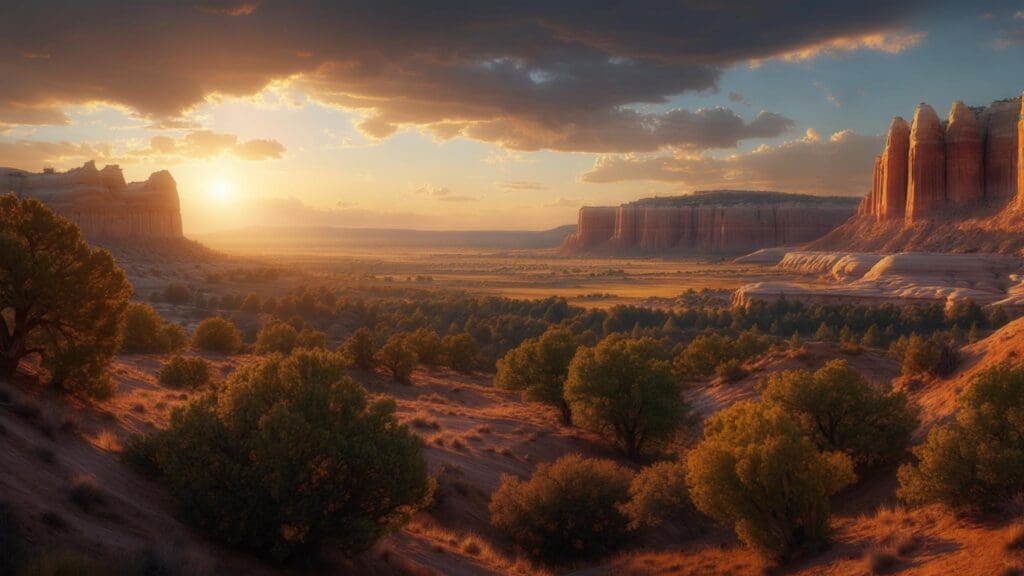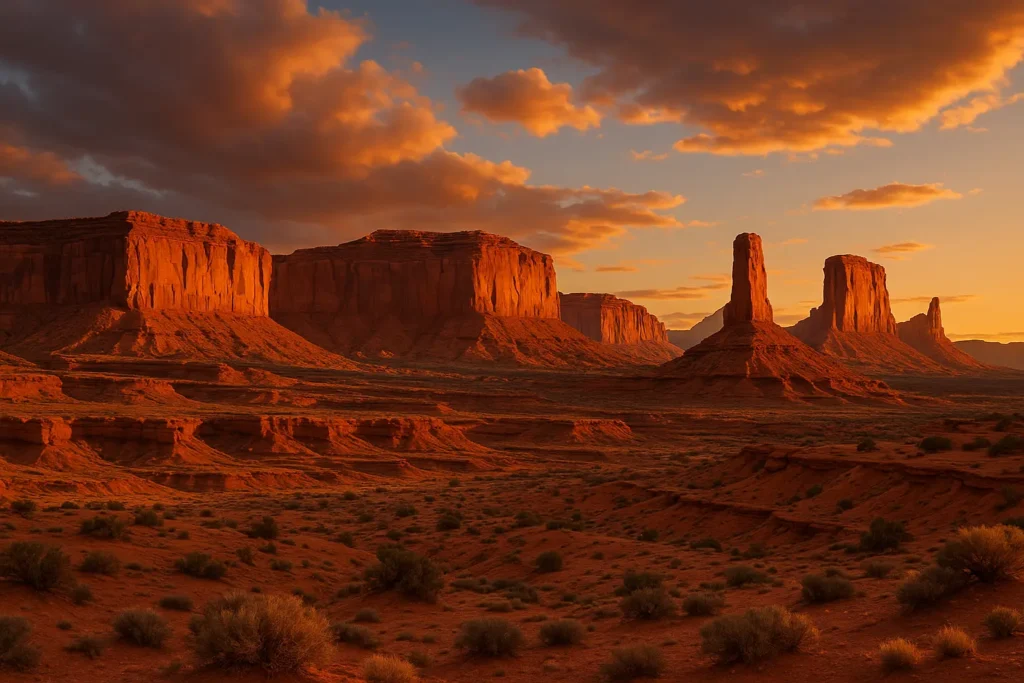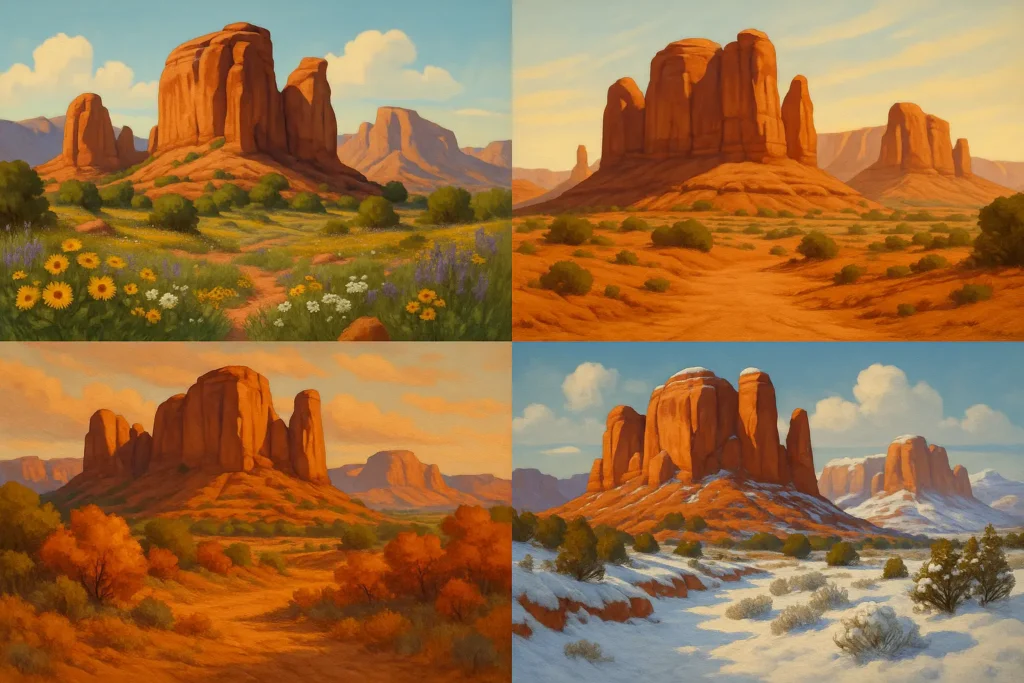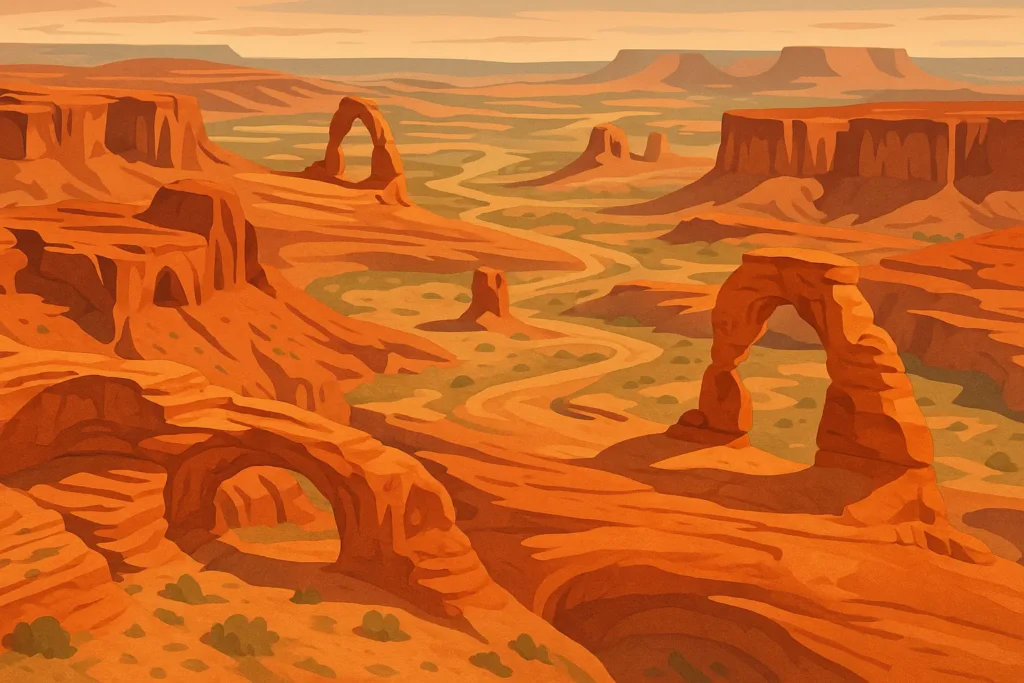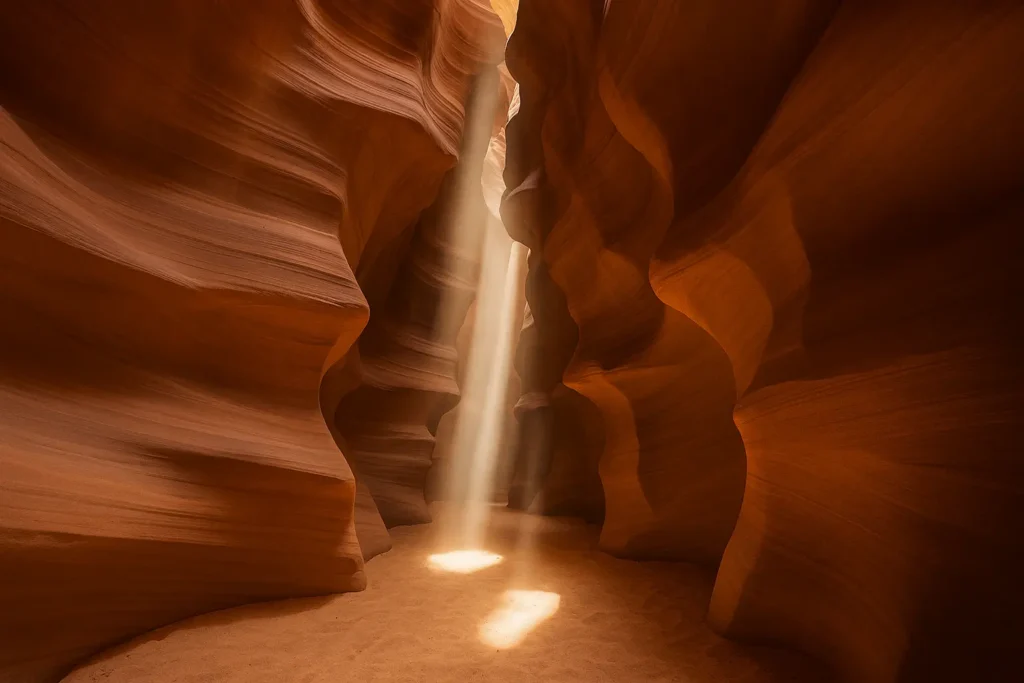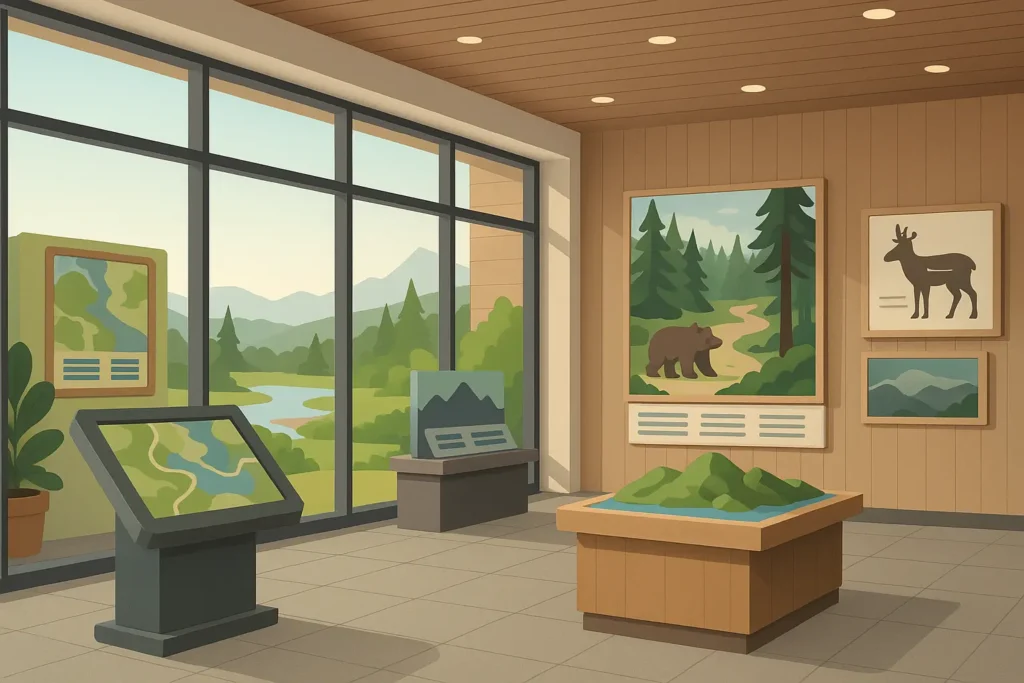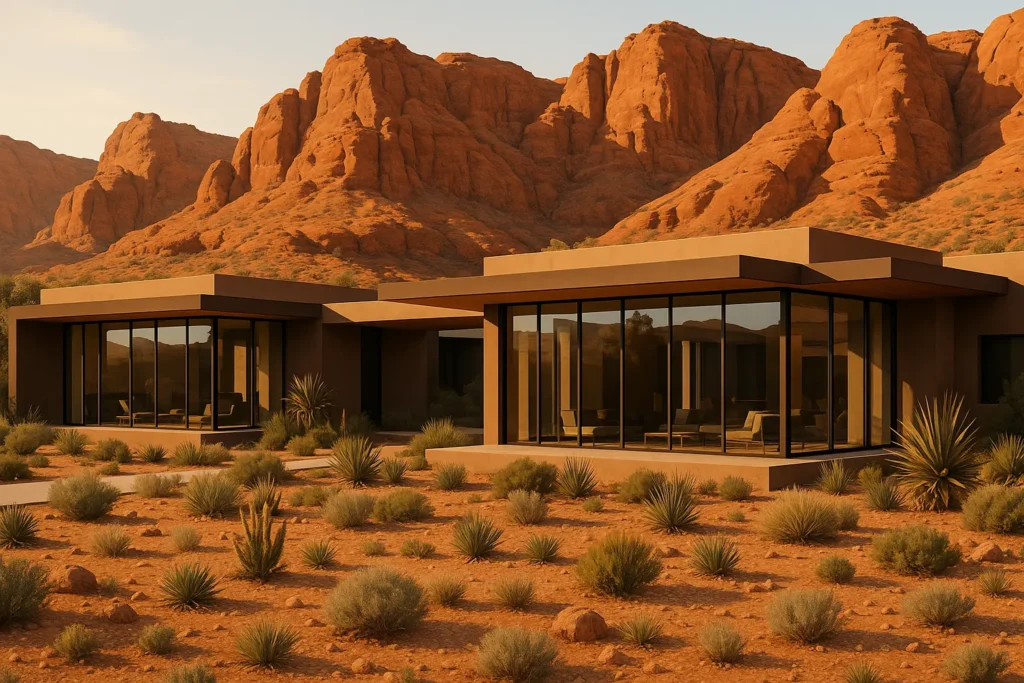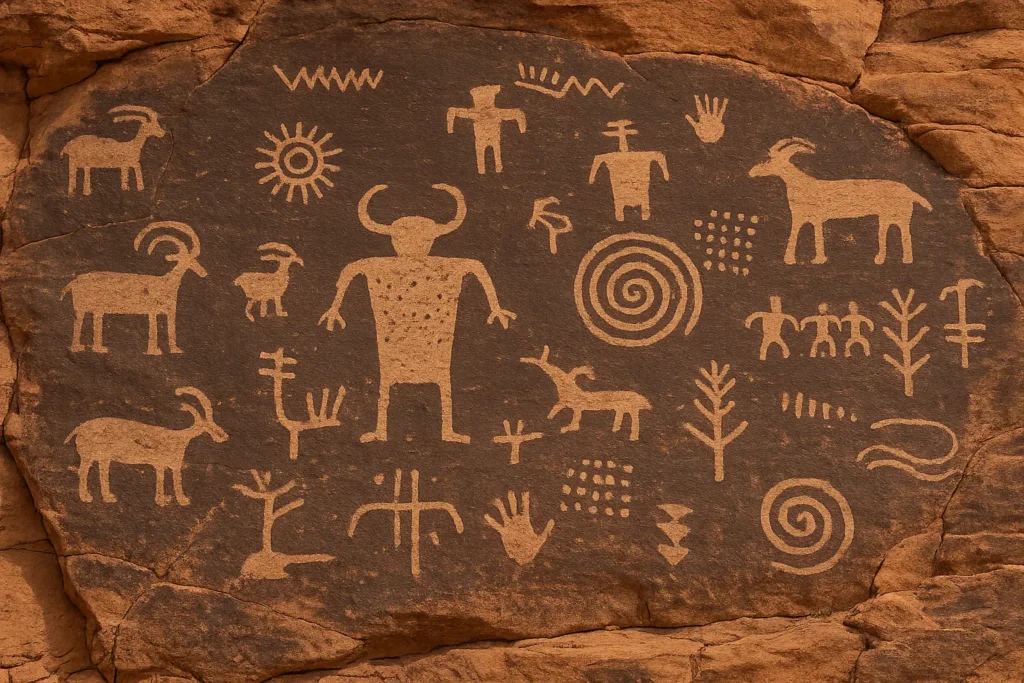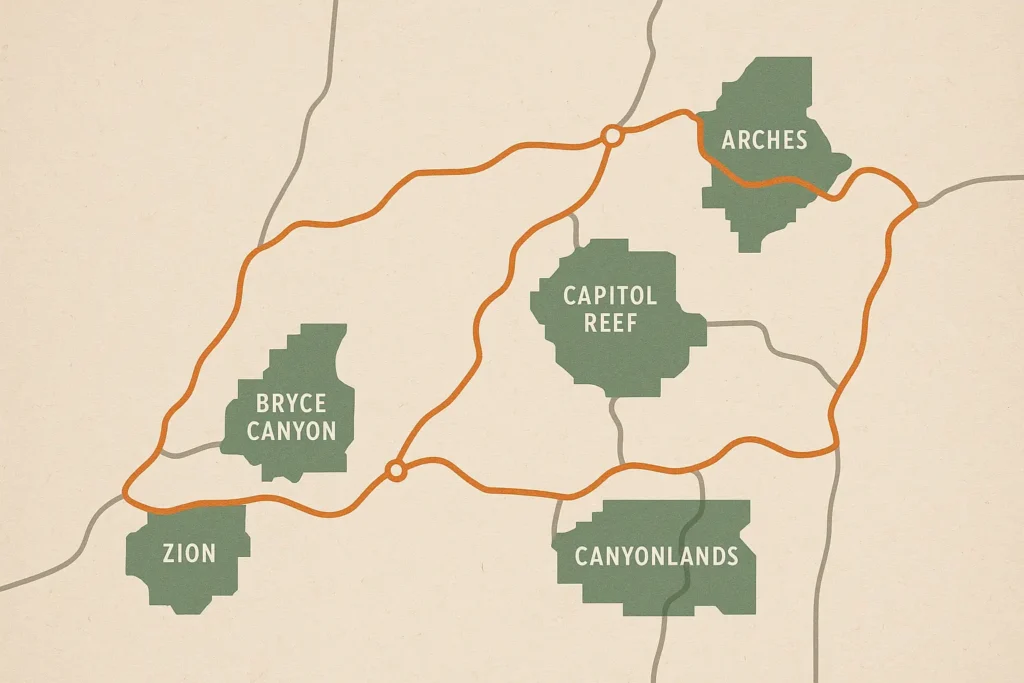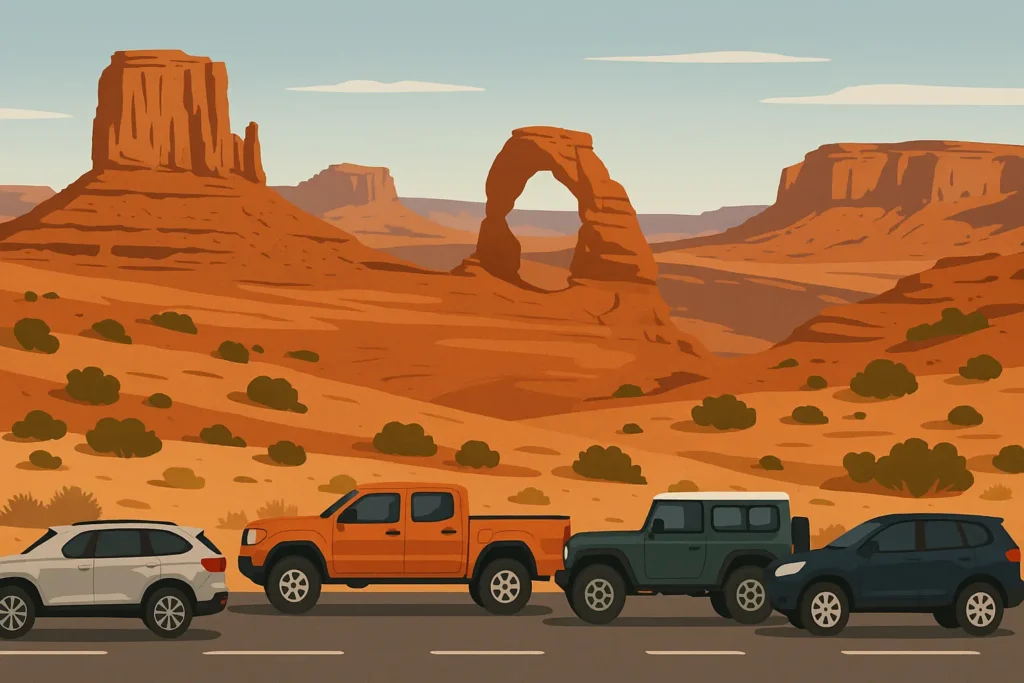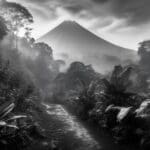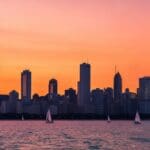Utah attracts over 5 million visitors annually to its national parks alone, and honestly? I get why people are overwhelmed trying to plan their trip. I spent weeks staring at my computer screen, drowning in contradictory travel guides that all promised the “perfect” Utah adventure. One blog said to skip Capitol Reef, another called it a hidden gem. Talk about confusing.
Simplify your Utah adventure with our Vacation Planner
Quick Resources
-
Build your custom Utah trip with the Vacation Planner
-
Explore more options on our wedding tools page
Look, planning a Utah itinerary shouldn’t make you want to cancel your trip before you even book it. Whether you’re dreaming of hitting all five national parks or just want to chill among red rocks without the stress, the right plan makes all the difference between coming home exhausted and coming home inspired.
I’ve broken down 25 different Utah itineraries that actually work in the real world – not just on paper. From classic road trips through the Mighty Five to luxury escapes where someone else does the planning, you’ll find options that match your style, budget, and energy level. No more analysis paralysis, just real advice from someone who’s made these mistakes so you don’t have to.
Match your perfect itinerary with our Vacation Planner
Real Talk About Utah Planning
Let me be brutally honest here – I spent three weeks researching Utah trips and still felt completely overwhelmed. Every blog promised the “ultimate” itinerary, but none of them mentioned that you’ll be driving for HOURS between parks, or that finding gas in some areas is like finding a unicorn.
Here’s what I wish someone had told me straight up:
Time and Season – The Stuff That Actually Matters
Summer in Utah isn’t just hot – it’s “your water bottle becomes lava” hot. I made the rookie mistake of visiting Arches in July at 2 PM. Big mistake. HUGE. The metal handrails were literally too hot to touch, and I watched a family turn around halfway through Delicate Arch because their kid was melting down (literally and figuratively).
But here’s the thing nobody mentions – winter Utah is absolutely gorgeous. Sure, you can’t hike everywhere, but you’ll have places like Bryce Canyon practically to yourself. I took some of my favorite photos ever with snow-dusted hoodoos and not another soul in sight.
Spring (April-May) and fall (September-October) are the sweet spots if you can swing it. The weather’s perfect, crowds are manageable, and you won’t melt or freeze. Just know that some high-elevation spots might still have snow in early spring – learned that one the hard way trying to reach a “totally accessible” viewpoint in May.
Use our Vacation Planner to choose the best season for your trip
| Season | The Good Stuff | The Not-So-Good | Best For |
|---|---|---|---|
| Summer (Jun-Sep) | Everything’s open, long days | Brutal heat, insane crowds, expensive everything | First-timers who can only travel in summer |
| Spring (Apr-May) | Perfect weather, wildflowers | Some trails still snowed in | Photography lovers, moderate budgets |
| Fall (Sep-Oct) | Amazing temperatures, gorgeous light | Shorter days, some places start closing | Anyone who can travel off-peak |
| Winter (Nov-Mar) | Peaceful, snow-covered beauty, skiing | Limited access, cold | Ski lovers, luxury lodge seekers |
Let’s Talk Money (Because Someone Has To)
Those budget breakdowns you see online? Add 30%. Seriously. Gas prices in gateway towns are insane, that “quick lunch” at Zion costs $18 for a mediocre sandwich, and don’t get me started on last-minute hotel rates.
My actual spending for a week-long Mighty Five trip (2 people):
- Hotels (because camping in 100-degree heat is torture): $1,800
- Food (mix of grocery store and restaurants because we’re human): $800
- Gas (ouch): $400
- Random stuff we didn’t budget for: $300
- Total: Way more than we planned
Budget travelers can definitely do Utah cheaper – camping keeps costs down, and cooking your own meals helps. But be realistic about what “budget” means to you. If you’re miserable camping in the desert heat, those hotel costs become worth every penny.
Group Dynamics – The Uncomfortable Truth
If someone in your group hates hiking, don’t drag them to Utah thinking they’ll magically love it. My friend spent our entire Zion day complaining about her feet while the rest of us wanted to explore. It was awkward for everyone.
Also, that friend who says they’re “totally fine with camping”? Test that theory on a weekend trip first, not during your Utah vacation. Trust me on this one.
Fitness Reality Check
Be honest about your fitness level. If you get winded climbing two flights of stairs, maybe don’t make Angels Landing your first hike. (Ask me how I know…) Utah has options for every fitness level, but some trails will humble you real quick.
The good news? Places like Bryce Canyon’s Rim Trail and Arches’ Windows Section offer incredible views without requiring mountaineering skills. Save the epic challenges for when you’re ready.
Transportation and the Great Utah Road Trip
Utah is HUGE. That cute little map makes everything look close together. It’s not. The complete Mighty Five circuit is over 1,200 miles of driving. Factor in actual drive times, plus stops for gas, food, and bathroom breaks.
Plan smarter routes with our Vacation Planner
Most Utah road trip adventures need a decent rental car – nothing fancy, but something reliable with good air conditioning. If you’re planning backcountry exploration, upgrade to high-clearance or 4WD. Standard cars work fine for all the national parks’ main attractions.
Classic National Parks Road Trips (Utah Mighty Five Focus)
The Utah national parks road trip is basically a rite of passage for outdoor lovers. These five parks showcase everything from towering red cliffs to delicate natural arches, and honestly, they’re all incredible in their own way.
1. The Complete Mighty Five Circuit (14-21 days)
This is the holy grail of Utah national parks itinerary options – hitting all five parks in one epic journey. Sounds amazing, right? It is, but let me set expectations: you’ll be exhausted by day 10 and start taking “quick photos” instead of actually enjoying places.
The route typically goes: Salt Lake City → Zion → Bryce Canyon → Capitol Reef → Arches → Canyonlands → back to Salt Lake. It’s logical, scenic, and will give you serious bragging rights. Just build in rest days – seriously, you’ll thank me.
This Utah itinerary works best for people who need to check all the boxes and have the time to do it right. Don’t rush it just to say you did it.
Map your Mighty Five road trip with our Vacation Planner
2. Southern Utah Scenic Loop (7-10 days)
This is my personal favorite. You hit the greatest hits without the marathon driving sessions. Zion to Bryce is gorgeous, Bryce to Capitol Reef is manageable, and you can actually enjoy your mornings instead of packing up camp at dawn.
The loop focuses on the three most accessible and visually stunning parks. You’ll stay in charming gateway towns, experience incredible diversity from river canyons to high-elevation forests, and still have energy to enjoy good meals and comfortable beds.
3. Eastern Utah Adventure (5-7 days)
Perfect if you want to base somewhere and explore. Moab has actual restaurants, real showers, and you don’t have to pack/unpack every day. Plus, both Arches and Canyonlands are incredible, and you’re in the heart of adventure sports central.
This concentrated approach lets you really dig into two amazing parks while enjoying Moab’s surprisingly good food scene. The red rock landscapes around here are what most people picture when they think “Utah.”
4. Zion and Bryce Highlights (4-5 days)
The perfect introduction to Utah for first-timers or anyone with limited time. Both parks offer excellent shuttle systems (no driving stress!), well-maintained trails, and that jaw-dropping scenery that makes Utah famous.
You can experience iconic hikes like Angels Landing and the Narrows, plus easier options like the Rim Trail at Bryce. It’s enough to get a taste without overwhelming yourself.
5. Utah Mighty Five Photography Tour (10-14 days)
Designed for people who care more about getting the perfect shot than covering maximum ground. This Utah national parks itinerary prioritizes golden hour lighting and unique angles over checking boxes.
You’ll visit each park during its photographic sweet spot, with built-in flexibility for weather delays. Expect lots of early mornings and late evenings, but the images you’ll capture make it worth the effort.
Adventure and Outdoor Recreation Itineraries
If sitting in a car looking at scenery isn’t your thing, these active Utah itineraries will get your heart pumping. Fair warning: some of these require serious fitness and skills.
6. Utah Canyoneering Expedition (7-10 days)
Let me be that person – canyoneering looks way cooler on Instagram than it feels when you’re rappelling into a slot canyon questioning your life choices. It’s amazing, but know what you’re signing up for.
Utah has some of the world’s best slot canyons, from beginner walks in Capitol Reef to technical descents in Zion that require ropes and nerves of steel. Professional guides teach you the skills while keeping you safe, but this isn’t for everyone.
Progression from Beginner to Expert:
- Start with wide canyons and basic walking
- Learn rappelling and anchor systems
- Progress to technical multi-pitch descents
- Master route-finding and problem-solving
7. Mountain Biking Utah (5-8 days)
Moab’s mountain biking is legendary for a reason. It’s also legendary difficult. Those “beginner” trails? They’re beginner by Moab standards, which means they’d be intermediate anywhere else.
The variety is incredible though – from red rock desert riding to high-alpine singletrack. Bike rentals and guide services are everywhere, and the scenery makes even the tough climbs worth it.
8. Utah Skiing and Winter Sports (4-7 days)
Utah’s “Greatest Snow on Earth” reputation is legit. The powder here is different – lighter, fluffier, and there’s lots of it. This Utah itinerary combines world-class skiing with Olympic history and surprisingly good après-ski.
Beyond downhill skiing, cross-country and backcountry options abound. Some of the most beautiful winter scenery you’ll ever see, plus hot chocolate tastes better at altitude.
9. Rock Climbing and Bouldering Tour (6-9 days)
If you’ve never climbed before, Utah isn’t where you learn. Take a class at home first, then come here to be amazed. The climbing here spans from Zion’s big walls to Indian Creek’s perfect crack climbing.
Different areas offer different rock types and climbing styles. Guided instruction is available, but having basic skills before you arrive makes the experience much better.
10. Utah Backpacking Circuit (10-14 days)
Multi-day backpacking gets you to places day hikers never see. We’re talking about true wilderness, nights under star-filled skies, and that sense of accomplishment that comes from carrying everything you need on your back.
Permits are required for most backcountry areas, so plan ahead. This Utah itinerary demands good physical condition and backcountry experience, but the payoff is incredible.
Family-Friendly Utah Experiences
Traveling with kids in Utah requires different strategies, but don’t let that scare you off. These family-focused Utah itineraries account for shorter attention spans, bathroom emergencies, and the inevitable “are we there yet?” moments.
11. Utah Family Road Trip (7-10 days)
Real talk for parents: kids under 5 will melt down in the heat. Plan accordingly. The Junior Ranger programs are actually pretty cool and give you 30 minutes to sit down. Bring way more snacks than you think you need.
This kid-friendly version focuses on shorter hikes, interactive visitor centers, and hotels with pools for evening recovery. That “easy” 1-mile trail feels like 5 miles with a complaining 8-year-old, so build in extra time and patience.
12. Educational Utah Adventure (5-7 days)
Combining national parks with museums and hands-on learning creates a well-rounded experience. Kids love the fossil dig experiences and dinosaur trackways – way cooler than regular school!
This works great for homeschooling families or anyone who wants vacation with educational value. The hands-on experiences make learning fun instead of feeling like work.
13. Utah National Parks with Teens (6-8 days)
Teens are different – they’ll complain about everything until they see something Instagram-worthy, then suddenly they’re into it. Angels Landing? They’ll brag about it forever. Just make sure they’re actually capable of doing it safely.
Photography challenges, rock climbing instruction, and those perfect Instagram spots keep teens engaged. Plus, they appreciate good food and comfortable beds more than little kids do.
14. Multi-Generational Utah Tour (8-12 days)
Accommodating everyone from grandparents to grandchildren is tricky but doable. The key is flexibility – some family members tackle challenging hikes while others enjoy scenic drives and visitor centers.
This Utah national parks itinerary emphasizes activities that different generations can enjoy together or separately, with comfortable accommodations and accessible options for everyone.
15. Utah Summer Camp Experience (5-7 days)
Action-packed adventures for active families include river rafting, horseback riding, and camping under the stars. Professional guides provide instruction and safety oversight, so parents can participate instead of just supervising.
The summer camp atmosphere encourages families to try new activities together while building confidence and creating memories that’ll last way longer than any souvenir.
Luxury and Wellness Retreats
Sometimes you want Utah’s beauty without the camping, hiking, and general roughing it. These luxury Utah itineraries combine incredible scenery with high-end comfort and service.
16. Utah Luxury Lodge Experience (5-8 days)
Yes, places like Amangiri are expensive. Yes, they’re worth it if you can afford it. The helicopter arrival alone is worth the Instagram story, and the spa treatments after hiking are divine.
These resorts occupy prime locations with exclusive access to trails and viewpoints other visitors can’t reach. Private guides, gourmet dining, and world-class spas create memories that justify the premium investment.
17. Utah Wellness and Mindfulness Retreat (4-6 days)
Sunrise yoga overlooking red rock formations, guided meditation in slot canyons, and spa treatments using local minerals create a restorative experience that’s way more meaningful than typical sightseeing.
The retreat format emphasizes slowing down and actually connecting with nature instead of just checking it off a list. You’ll return home refreshed instead of needing another vacation.
18. Utah Romantic Getaway (3-5 days)
Private tours that avoid crowds, sunset dinners in spectacular settings, and couples massage treatments make this perfect for anniversaries or proposals. The dramatic landscapes provide pretty incredible backdrops for romantic moments.
Professional photographers can capture engagement sessions against Utah’s scenery – way better than your typical city backdrop.
19. Utah Culinary and Wine Tour (4-6 days)
Utah’s food scene is way better than you’d expect. Award-winning restaurants in unexpected locations, local breweries, and unique dining experiences paired with national park visits create a sophisticated adventure.
Farm-to-table restaurants and cooking classes featuring regional ingredients add a foodie element that appeals to travelers who appreciate both natural beauty and exceptional dining.
20. Utah Glamping Adventure (5-7 days)
This is perfect for people who want the “outdoor experience” without the “sleeping on rocks experience.” No shame in that game. Luxury tents and cabins near national parks provide comfort while still connecting you with nature.
Real beds, private bathrooms, and climate control, but you still hear the coyotes at night and see incredible stars. It’s the best of both worlds.
Cultural and Historical Journeys
Utah’s human history spans thousands of years, from ancient Native American cultures to Mormon pioneers to mining booms
21. Utah Native American Heritage Tour (6-8 days)
Ancient petroglyphs and archaeological sites tell stories that go back thousands of years. You’ll explore rock art panels with tribal guides who can explain what you’re actually looking at – way more meaningful than just snapping photos.
Please, please be respectful here. Don’t climb on petroglyphs for photos. Don’t take artifacts. These places are sacred, not just pretty backdrops for your Instagram. The guided tours provide context that makes the experience much richer than just wandering around on your own.
22. Mormon Pioneer Trail Experience (5-7 days)
Following the historic Mormon Pioneer Trail reveals an incredible migration story that shaped Utah’s identity. Temple Square, pioneer museums, and historic settlements tell the story of religious persecution leading to the establishment of a unique society in Utah’s remote valleys.
The Utah national parks itinerary includes both famous sites and lesser-known locations where pioneer history comes alive through preserved buildings and artifacts. It’s fascinating American history that most people don’t know much about.
23. Utah Ghost Towns and Mining History (4-6 days)
Way cooler than they sound. Utah’s mining heritage left behind boom-and-bust cycles and fascinating ghost towns scattered across remote landscapes. Just bring water – lots of it – and maybe download some maps offline because cell service is nonexistent.
The scenic drives between ghost towns traverse some of Utah’s most beautiful and remote areas. Many sites need high-clearance vehicles, adding adventure to the historical exploration.
24. Utah Dinosaur and Paleontology Tour (5-7 days)
Participating in actual fossil excavations and learning from professional paleontologists beats any museum visit. Utah preserved one of the world’s most complete dinosaur fossil records, and you can be part of ongoing discoveries.
Hands-on experiences include fossil preparation and guided tours of active dig sites. Way more engaging than just looking at bones in display cases.
25. Utah Arts and Culture Circuit (4-6 days)
Utah’s contemporary arts scene draws inspiration from the surrounding landscapes. You’ll visit galleries featuring regional artists and discover how Utah’s natural beauty influences everything from photography to sculpture.
The circuit includes Salt Lake City’s urban arts district and smaller communities where local artists create work inspired by red rocks and desert landscapes.
Detailed Itinerary Examples and Full Breakdowns
Here’s where theory meets reality. Three complete examples show exactly how these Utah itineraries work day by day, including the stuff other guides don’t mention – like where to actually eat lunch and what happens when your kid has a meltdown at mile 2.
The Complete Mighty Five Circuit (14-21 days) – Real World Version
Days 1-2: Salt Lake City – Don’t Rush This Part
Fly into Salt Lake City and get your rental car (SUV recommended – you’ll appreciate the space and clearance). Buy your National Parks Annual Pass online or at REI to save time later. Stock up on road trip supplies: cooler, snacks, first aid kit, extra water.
Visit Temple Square if you’re into history, or just explore downtown’s surprisingly good food scene. Stay downtown for walkability or near the airport if you’re leaving early. Pro tip: Grab dinner at Red Iguana for incredible Mexican food – you won’t find anything this good near the parks.
Days 3-5: Zion National Park – Prepare for Crowds
Drive to Springdale (4.5 hours with stops). Check into your hotel and immediately make shuttle reservations if it’s peak season. Day one: Riverside Walk and Lower Emerald Pool – easy ways to get oriented and test your hiking legs.
Day two: Angels Landing if you got permits (book months ahead) or Observation Point for similar views with fewer people. Day three: The Narrows day hike – rent gear in town or bring water shoes and a walking stick.
Reality check: Angels Landing permits sell out in minutes. Have backup plans. The Narrows can be cold even in summer – that river water doesn’t warm up much.
Days 6-8: Bryce Canyon – Embrace the Elevation Change
Drive to Bryce (2 hours) and immediately notice the temperature drop – it’s 8,000+ feet here. Visit Sunset Point first for that classic hoodoo view that’ll make you understand why people love this place.
Day one: Rim Trail between viewpoints – mostly paved and spectacular. Day two: Navajo Loop and Queen’s Garden combination gets you down among the hoodoos. Day three: sunrise at Bryce Point (worth the early wake-up) and Peek-a-Boo Loop if you’re feeling ambitious.
Days 9-11: Capitol Reef – The Hidden Gem
Capitol Reef gets overlooked, but it shouldn’t be. Start with the visitor center and Petroglyphs Trail – easy introduction to both the geology and human history. The scenic drive through Capitol Gorge is beautiful and historically interesting.
Day two: Hickman Bridge trail and Cohab Canyon for that slot canyon experience without technical difficulty. Day three: Cathedral Valley if you have high-clearance 4WD, or stick to easier trails like Goosenecks Overlook.
Days 12-16: Moab Base Camp – Finally, Some Stability
Set up in Moab for four nights – no more packing and unpacking! Day one: Arches highlights including Delicate Arch (go early to avoid crowds) and the Windows Section.
Day two: Fiery Furnace guided tour (book ahead) and Landscape Arch. Day three: Canyonlands’ Island in the Sky district, Mesa Arch for sunrise, and Grand View Point. Day four: White Rim Road scenic drive or the Needles district if you want different scenery.
Days 17-18: Recovery and Departure
Drive back to Salt Lake City with stops in small towns for antique shopping or just leg stretching. Use your final day for gear returns, last-minute shopping, and actual rest before flying home.
What I wish I’d known: Build in buffer days. Weather happens, cars break down, and sometimes you just want to sleep in. The rigid schedule looks good on paper but real life is messier.
Utah Family Road Trip (7-10 days) – Kid-Tested Reality
Day 1: Salt Lake City Family Orientation
Great Salt Lake State Park lets kids experience floating in super salty water – they’ll think it’s magic. The Discovery Gateway Children’s Museum provides hands-on Utah education that actually keeps kids engaged.
Stay at a hotel with a pool and free breakfast. Trust me, the pool will be your salvation after long car rides, and breakfast logistics are way easier when someone else handles them.
Days 2-3: Zion with Kids – Manage Expectations
Focus on shorter trails that still deliver: Riverside Walk is paved and leads to The Narrows entrance where kids can wade safely. Lower Emerald Pool has a waterfall that fascinates children.
Junior Ranger programs keep kids engaged while giving parents a break. The visitor center is air-conditioned relief during hot afternoons. Stay in family suites with kitchenettes for snack prep and flexible meal timing.
Reality check: That “easy” 1-mile trail becomes an epic adventure with kids. Build in extra time for everything, and accept that you won’t see as much as you would solo.
Days 4-5: Bryce Canyon Family Fun
The Rim Trail is mostly paved and offers incredible views without strenuous hiking. Multiple viewpoints provide variety and photo ops while accommodating different energy levels.
Sunset Point provides perfect family photos, and the visitor center has educational exhibits when weather doesn’t cooperate. Stay in family cabins for the novelty factor – kids love cabin life.
Days 6-7: Capitol Reef Learning Experience
Petroglyphs Trail combines easy walking with ancient rock art that captures kids’ imagination. The Fruita Historic District offers pioneer history through preserved buildings and orchards that kids can explore.
Capitol Gorge’s Pioneer Register shows signatures carved over 100 years ago – kids love finding the oldest ones. The Ripple Rock Nature Center is designed specifically for families.
Days 8-9: Moab Family Adventures
Arches’ Windows Section provides easy access to multiple natural arches via short walks. The Fiery Furnace offers guided family tours that feel adventurous while staying safe.
Consider the family-friendly Canyonlands by Night boat tour for evening entertainment that’s different from hiking. Stay at family resorts with pools and game rooms.
Day 10: Survival and Departure
Plan playground stops, ice cream breaks, and anything else that maintains sanity during the drive home. Accept that the last day is about survival, not sightseeing.
Utah Luxury Lodge Experience (5-8 days) – When Money’s No Object
Days 1-2: Amangiri – Dramatic Arrivals
Private helicopter from Las Vegas creates an unforgettable arrival at this ultra-luxury desert resort. Your suite has floor-to-ceiling windows framing mesas and a private terrace for stargazing.
Spa treatments use local clay and minerals in therapies designed to connect you with the desert. Private Antelope Canyon tours provide exclusive access with professional photography instruction. Gourmet meals feature local ingredients prepared by award-winning chefs.
Days 3-4: Sorrel River Ranch – Moab Luxury
Luxury suites overlook the Colorado River with private patios perfect for sunrise coffee. Your private Arches guide provides expert knowledge and access to viewpoints that avoid crowds through strategic timing.
Horseback riding through red rock country offers different perspectives, while couples massage treatments feature canyon views. Private chef dinners under stars create romantic moments worth the premium investment.
Days 5-6: Montage Deer Valley – Mountain Contrast
Mountain luxury suites provide Wasatch Range views with private balconies and fireplaces. Your private hiking guide leads you to hidden waterfalls and alpine meadows most visitors never discover.
Spa treatments and wellness activities take advantage of the mountain setting. Optional hot air balloon rides provide aerial perspectives of mountains and valleys.
Days 7-8: Grand America Hotel – Urban Luxury
Presidential suite accommodations provide urban luxury contrasting your outdoor adventures. Private city tours include Temple Square and exclusive shopping with personal assistance.
Farewell dinners at award-winning restaurants celebrate your Utah adventure with exceptional cuisine and wine pairings.
How Each Itinerary Actually Works in Real Life
Different Utah itineraries perform better or worse depending on when you go, how fit you are, what you want to spend, and who you’re traveling with. Here’s the honest breakdown of what works when:
| Itinerary Type | Best Season | Fitness Needed | Daily Budget | Works Best For | Vehicle Requirements |
|---|---|---|---|---|---|
| Mighty Five Circuit | Spring/Fall | Moderate | $200-350 | Couples, small groups | Standard SUV |
| Adventure Tours | Spring/Summer | High | $250-400 | Fit adventurers | High-clearance |
| Family Road Trip | Summer | Low-Moderate | $150-250 | Families with kids | Large SUV/Van |
| Luxury Lodges | Year-round | Low | $500-1000+ | Special occasions | Provided transport |
| Cultural Tours | Fall/Winter | Low | $100-200 | History buffs | Standard car |
Seasonal Reality Check
Summer (June-September): Everything’s accessible, but you’ll melt and fight crowds. Family trips work because kids are out of school, but expect to pay premium prices for everything.
Spring/Fall: Perfect weather and fewer crowds make most Utah national parks itinerary options ideal. Photography tours especially shine with better lighting and comfortable temperatures.
Winter: Skiing itineraries obviously peak, while luxury lodges adapt activities seasonally. Many high-elevation areas become inaccessible, but you’ll have incredible solitude.
Fitness Level Truth
Low Fitness: Luxury experiences, scenic drives, and cultural tours work perfectly. Don’t feel bad about choosing comfort – Utah’s beauty is accessible at every fitness level.
Moderate Fitness: Most Utah road trip options work well here. You can choose easier or harder options at each stop based on how you’re feeling.
High Fitness: Adventure tours, backpacking, and technical activities require serious conditioning. Be honest about your capabilities – Utah will humble you quickly if you’re not prepared.
Budget Reality
Budget ($100-200/day): Camping-based trips work, but comfort suffers. Off-season travel and self-guided tours provide good value.
Mid-Range ($200-400/day): Sweet spot for most travelers. Hotel stays, some restaurants, occasional guided activities without breaking the bank.
Luxury ($400+/day): Premium lodges, private guides, exclusive experiences. Worth it for special occasions if you can afford it.
Group Dynamics That Actually Matter
Solo Travel: Maximum flexibility for photography tours, cultural exploration, and adventure activities with group-joining options.
Couples: Romantic getaways and luxury experiences designed for two. Modified family itineraries work great when adjusted for adult interests.
Families: Specialized family itineraries account for varying ages and interests. Educational tours provide engaging activities for different age groups.
Friend Groups: Adventure tours and group camping experiences excel for shared challenges and social activities.
Transportation and Logistics Reality
Simple: Luxury lodges handle transportation. Cultural city tours and established family routes require minimal specialized planning.
Moderate: Mighty Five circuits need multiple accommodation bookings and permit coordination across vast distances.
Complex: Canyoneering expeditions require specialized gear and safety equipment. Remote cultural sites demand expert-level planning with multiple backup options.
Crowd Management Strategies
Low Crowd Impact: Winter sports, off-season cultural tours, remote backpacking naturally avoid crowds through timing or location.
Strategic Management: Most Utah national parks itinerary options can avoid crowds through early starts, weekday timing, and alternative routes.
High Tolerance Required: Summer family trips and peak season adventures require accepting busy conditions at popular destinations.
Bottom Line – Choose Your Own Adventure
Utah is incredible, but it’s not a theme park. It’s real wilderness with real challenges and real rewards. The key to a successful Utah itinerary is being honest about what you actually want to do, not what looks good on paper.
Want adventure? Go for the canyoneering or backpacking options. Prefer comfort? Luxury lodges provide incredible experiences without roughing it. Traveling with kids? Family-focused itineraries account for shorter attention spans and bathroom emergencies.
The beauty of having 25 different Utah itineraries to choose from is that there’s something for everyone. You don’t have to do the “classic” road trip if it doesn’t match your style. You don’t have to camp if you hate sleeping on the ground. You don’t have to hike Angels Landing if heights terrify you.
Most people who visit Utah end up planning return trips anyway. The state’s too diverse and amazing to see everything in one go. Pick an itinerary that matches what you want right now, not what you think you should want.
Craft your ideal Utah itinerary with our Vacation Planner
Remember – you can always come back. And trust me, you’ll want to.
1-800-BRIDESMAID
The Newlywed
Card Game
something extra to love
Read the weekly newsletter from Bridesmaid for Hire, 1-800-Bridesmaid, to hear about real stories, from strangers, who need advice on love, life, friendship, and so much more.
Looking for the perfect wedding gift for someone you adore? Grab The Newlywed Card Game. It's a fun and interactive game they can play on their honeymoon or future date nights.
